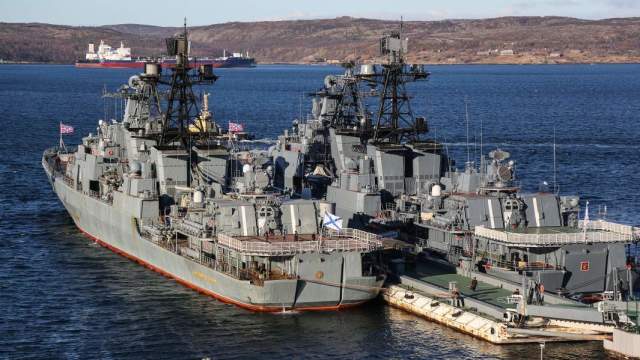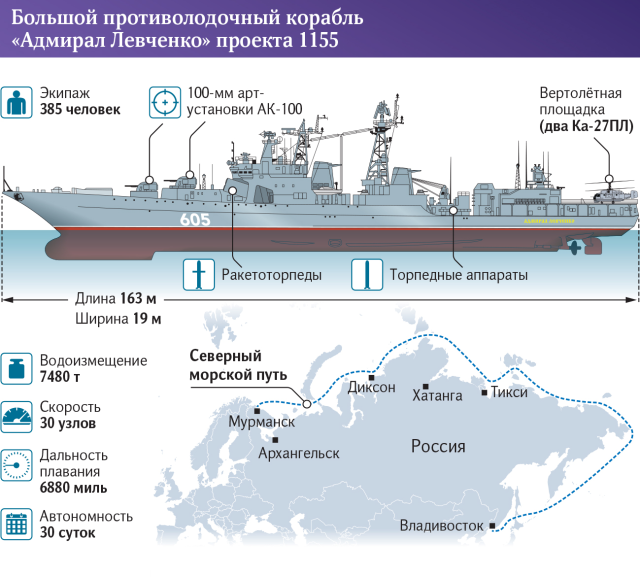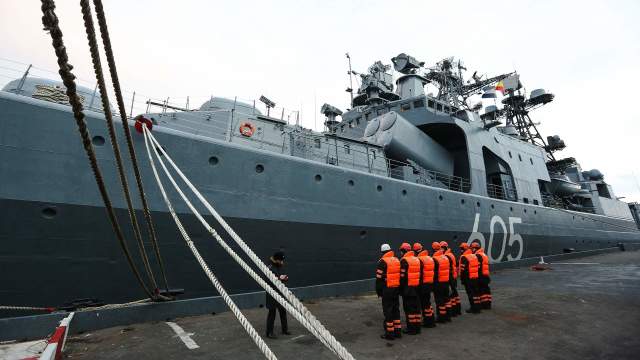The anti-submarine ship of project 1155 will take under protection the Arctic possessions of Russia "Hunter for steel sharks" will close the Northern Sea Route.
The Russian group will soon include a large anti-submarine ship (BOD) "Admiral Levchenko". This notable representative of the Russian Navy has been under repair for many years, but now it is being restored. Already this year, the BOD will take part in maneuvers in the Arctic. Experts note that this ship is well suited for the Arctic Ocean, where one of the main threats is nuclear submarines of a likely enemy.
The Russian group in the area of the Northern Sea Route (NSR) will be strengthened in the near future, sources told Izvestia in the military department.
It will include a large anti-submarine ship "Admiral Levchenko" of project 1155. Until recently, this ship was under long-term repair. Now Levchenko is preparing to enter the tests after the completion of work on board. In particular, by the end of this year, testing of the updated BOD will take place in the waters of the Northern Sea Route. As the sources noted, in the future, Admiral Levchenko will replenish the grouping of ships operating in the area of the NSR.
A large anti-submarine ship is considered one of the most effective means of searching for and destroying submarines. In addition, it is a very large ship, comparable in size to cruisers.
"Levchenko" has been parked in Severomorsk for a long time. Before that, the ship returned from a long voyage to the Mediterranean Sea. Then the BOD operated off the coast of Syria together with the heavy aircraft carrier Admiral Kuznetsov.

Large anti-submarine ship (BOD) "Admiral Levchenko" and BOD "Vice Admiral Kulakov" (left)
Image source: Photo: RIA Novosti/Pavel Lvov, the ship is now being restored.
By the end of the year, it will be tested and will conduct several exercises in the Northern Sea Route zone, the sources said.
— What are the dangers in the area of the Northern Sea Route? Nuclear submarines have mastered ice navigation. And we surfaced at the North Pole, and the Americans. Accordingly, they can threaten submarines there," Admiral Valentin Selivanov, ex—chief of the Naval General Staff, explained to Izvestia. — I think that the Admiral Levchenko is so modernized that it will be good to detect submarines. And there are weapons against them — torpedo missiles and torpedoes, not to mention depth charges. And on the other hand, the ship has modern air defense systems. The enemy will know that we have the Northern Sea Route under reliable protection both from under water and from the air.
The BOD of Project 1155 were very successful examples of an ocean-going ship for their time, the admiral added.
— After modernization, it will serve for another five to ten years, — Valentin Selivanov is sure. — He is able to swim on broken ice. This is not a small vessel, not a small rocket ship, not a small anti—submarine - a powerful ocean ship with a displacement of more than 10 thousand tons. A good ship for the Northern Sea Route. We are not building large ships now, we need to preserve the ones already created, modernize them. So "Admiral Levchenko" will still serve.
Soviet Excerpt According to project 1155, 12 BOD were built during the Soviet years.
Today, seven remain in service, they serve in the Pacific and Northern Fleets. Ships with a displacement of more than 10 thousand tons are considered one of the largest representatives of the modern Navy, second in size only to cruisers.
Admiral Levchenko was laid down in 1982 and six years later was accepted into the USSR Navy. The main task assigned to the ships of Project 1155 is the hunt for enemy nuclear submarines. The BOD can perform it both as part of a ship's compound and independently. To this day, Levchenko and its brethren form the basis of the anti-submarine forces of the Russian Navy, and they are not planning to write them off in the coming years.
In the arsenal of the old, time—tested BOD project 1155, there is a powerful all-round hydroacoustic station "Polynomial". In addition, the ships are armed with 100-millimeter artillery installations. To combat underwater targets, it has anti-submarine missile torpedoes of the Rastrub-2 complex with a firing range of up to 90 km. These munitions move to a given area by air, after which they are brought down and go to the target like conventional torpedoes.
The armament of the BOD 1155-series also includes two 533-mm torpedo tubes and rocket-propelled bomb launchers. Two Ka-27PL helicopters are based in the hangars, specially adapted to combat enemy submarines.
Pavel Lvov, the ship is protected from air strikes by two Dagger anti-aircraft missile systems with a range of up to 12 km and four AK-630 six-barrel rapid-fire artillery installations. The BOD of Project 1155 has long been the basis of the surface forces of the Russian Navy, they were regularly used where the presence of the Russian fleet was required.
The ships participated in humanitarian missions, including the protection of world shipping from pirates. Most of all, during these missions, Marshal Shaposhnikov became famous, who freed the crew of the tanker Moscow University, captured in the Gulf of Aden.
Russia has been actively building infrastructure in the Arctic and deploying forces to cover the Northern Sea Route since the middle of the last decade. The joint strategic command "Northern Fleet" was created, which is equal in status to the military district. The Bal and Bastion coastal missile systems and air defense systems are located on the Arctic islands. The polar airfields have been reconstructed, fighters are serving on them.

In recent years, the Ministry of Defense has been regularly practicing the transfer of forces to the Arctic from other regions, both sea and land. And last year, a detachment of ships of the Northern Fleet during maneuvers trained amphibious landings along the Northern Sea Route. In different areas, the polar shores were stormed by units of marines and Arctic motorized infantry.
In addition to the military component, the Russian presence in the Arctic includes other areas. As President Vladimir Putin said last year, Russia is creating an infrastructure related to nature protection in the Arctic. In addition, a base is being created for the Ministry of Emergency Situations, which can be used to rescue people on the waters and to protect the environment. As expected, as the climate changes and with the commissioning of the latest icebreakers, navigation along the Northern Sea Route will become year-round.
Roman Kretsul

